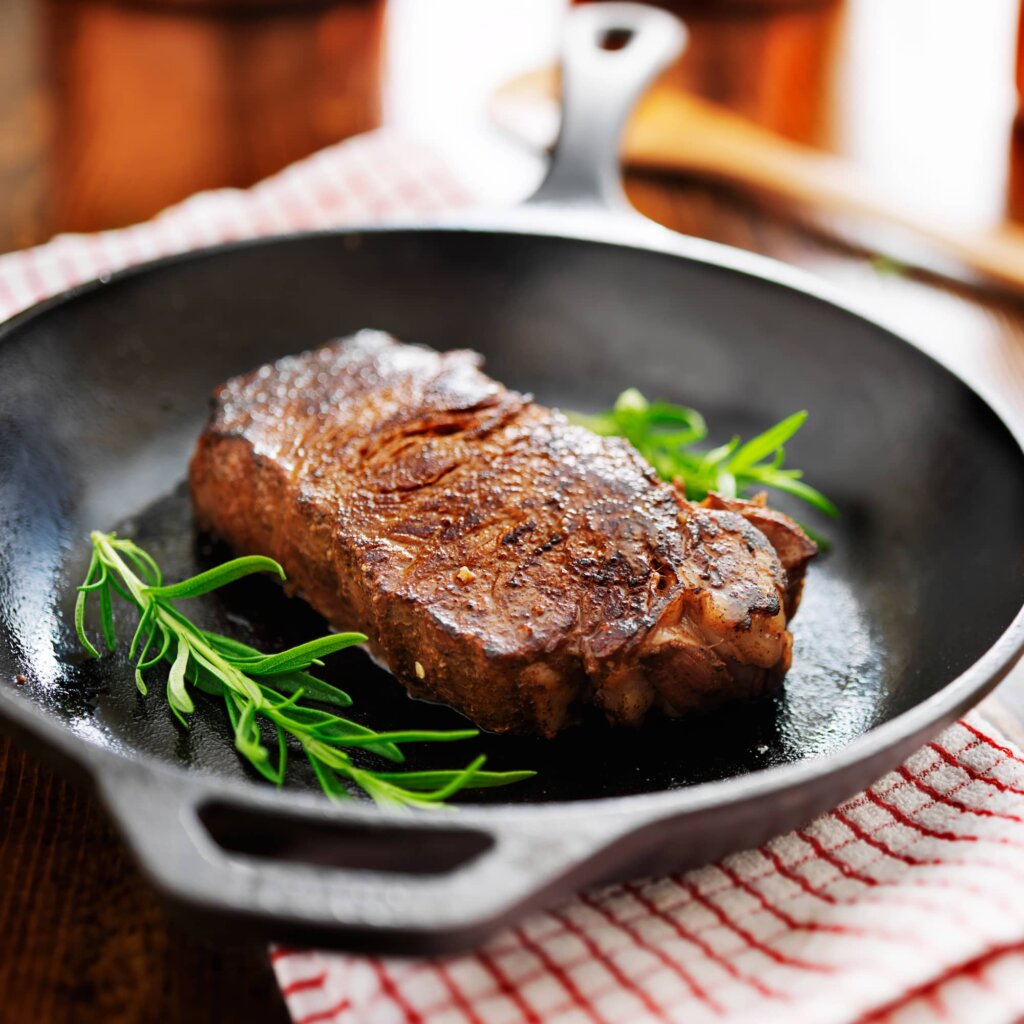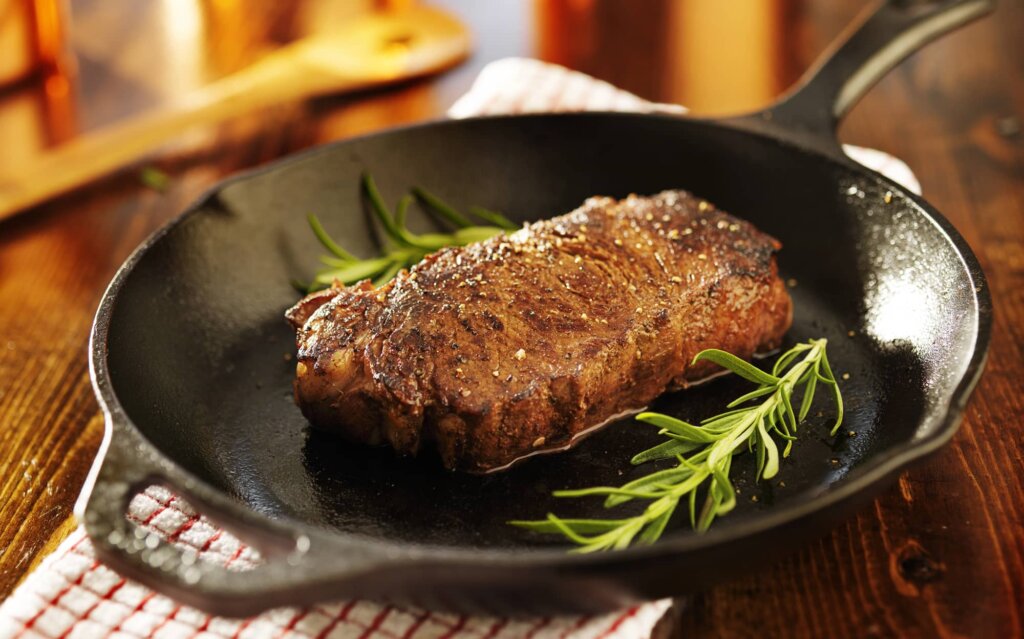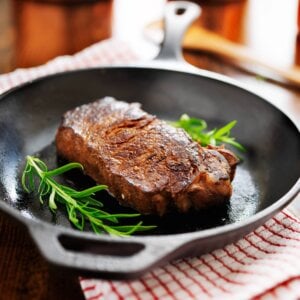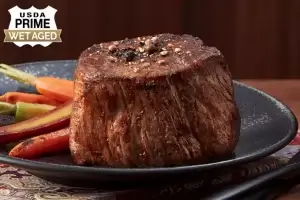
Strip steak is a steakhouse staple, and it might even be a common addition to your favorite dinner recipes at home. But instead of grilling it or pan searing it, have you tried the reverse sear method?
If not, continue reading our guide to learn how to reverse sear strip steak. Once you try its perfect sear and tender bite, you might never go back to the grill again.
Preparation for Reverse Sear Strip Steak
Let’s look at how to prepare for reverse searing strip steak:
Strip Steak Prep
First, get the steak ready. Remove it from the refrigerator and salt it generously on both sides. Then, let it rest at room temperature for 45 minutes to an hour to brine, which helps it crisp and tenderize.
Stove Prep
Get a cast-iron skillet ready to heat when your steak is almost done in the oven. Drizzle a small amount of olive oil in the pan while heating.
Oven Prep
When there are about 10 minutes left on the steak resting time, preheat the oven to 225 degrees, making sure an oven rack is in the middle position. Spray a rimmed baking sheet with cooking spray.
Cooking Time
Strip steak takes about 20-30 minutes to cook in the oven before it’s ready to sear if you’re cooking to medium-rare. Higher levels of doneness might need closer to 45 minutes or even an hour in the oven.
Final Temperature
We’ve created the temperature chart below to help you find the best temperature range for strip steaks when reverse-searing. For medium-rare, the steak should reach 125°F-130°F after cooking in the oven and 130°F-135°F after searing and resting.
| Steak Doneness | Temperature to Remove from Oven | Final Temperature |
| Medium-rare | 125°F-130°F | 130°F-135°F |
| Medium | 135°F-140°F | 140°F-145°F |
| Medium-well | 145°F-150°F | 150°F-155°F |
| Well-done | 155°F-160°F | 160°F-165°F |
Reverse Sear Strip Steak to Medium Rare
We recommend reverse searing strip steak to medium-rare by preheating the oven to 225 degrees and cooking for 20 minutes. Temp the steak with a thermometer and, if needed, place back in the oven for a few more minutes until it reaches 125°F-130°F. Then, sear in a hot skillet with oil for 2-3 minutes on each side. Rest for 5-10 minutes while loosely tented with foil before enjoying.
Reverse Sear Strip Steak Tips
Below, we’ve outlined a few tips to help you reverse sear strip steak:
Check After 20 Minutes
Because strip steak can be on the thin side, you don’t want to leave it in the oven too long, as it can overcook quickly. Check the steak after 20 minutes in the oven if cooking to medium-rare or medium to see if it’s reached the appropriate temperature range. You can always add it back to the oven if needed for a few minutes. Use a thermometer to accurately gauge the temperature by inserting the probe into the thickest part of the steak.
Use the Grill as an Alternative
In this guide, we walk you through the steps of reverse searing strip steak using your oven. However, you can still use the grill if you prefer. To do this, set the grill to 225 degrees or low flames. Check the steak after 20 minutes, but it may need extra time on the grill, depending on what type of grill you have. Then, sear as usual on the stove.
Choosing the Right Cut
There are a few different types of strip steaks you might find in the store. Here’s a quick guide on what to consider for reverse searing:
- Boneless vs. bone-in: Bone-in steaks generally take longer to cook than boneless steaks. Otherwise, they cook similarly, and either can work for reverse searing. If you don’t mind waiting a bit longer for your meal, choose bone-in strip steak for extra flavor and tenderness.
- Dry-aged vs. wet-aged: During the aging process, beef tenderizes and becomes more flavorful. Either one is an excellent choice, but wet-aging tends to be a quicker process and, therefore, sometimes more affordable.
- Premium Angus, USDA Prime, and Wagyu: These labels denote the quality of steak, and each is among the best quality your money can buy. Premium Angus is the most affordable option, but USDA Prime and Wagyu excel in marbling and overall quality.
Reverse Sear Strip Steak Instructions
Learn how to reverse sear strip steak using the steps below:
Step 1: Prepare for Cooking
Leave steaks at room temperature for at least 45 minutes before cooking. Right after removing them from the refrigerator, salt them generously on both sides.
Meanwhile, preheat the oven to 225 degrees with an oven rack moved to the middle position. Spray a baking sheet lightly with cooking spray.
Step 2: Reverse-Sear Strip Steak
Transfer the steaks to the baking tray and then into the oven. Cook for 20-30 minutes, using a thermometer to check the temperature after 20 minutes.
Heat a skillet to medium-high heat. Sear steaks for 2-3 minutes on each side until golden brown. Check the temperature again after searing using the temperature chart above.
Step 3: After Cooking
Move steaks to a clean plate or cutting board. Loosely tent foil over the steaks as they rest for 5-10 minutes. Then, slice against the grain and serve.
Reverse Sear Strip Steak Recipe

Serves: 2
Prep time: 45 minutes
Cooking time: 45 minutes-1 hour
Ingredients:
- 1-1 ½ pounds of strip steak
- Salt
- Pepper
- Cooking spray
- Olive oil
Instructions:
- Salt the steak generously on both sides. Set aside at room temperature for 45 minutes. Preheat the oven to 225 degrees, and spray a rimmed baking sheet with cooking spray.
- Transfer steaks to the baking sheet and into the oven on the middle rack. Cook for 20-30 minutes, depending on your desired doneness level. Preheat a skillet with a drizzle oil to medium-high heat. Sear steaks for 2-3 minutes on each side.
- Rest steaks on a foil-tented plate for 5-10 minutes.
Advantages & Disadvantages of Reverse Searing Strip Steak
Strip steak typically fares well with reverse searing, but it this method also has its downsides. Here’s what to expect:
Advantages
- Quicker than sous vide
- The sear from reverse searing is hard to beat
- Relatively hands-free cooking method
Disadvantages
- Some thinner strip steaks may overcook quickly
- Requires a slightly larger learning curve than other methods
- Takes longer than pan-searing
Reverse-Seared vs. Pan-Seared
Pan-searing requires you first to sear a steak in a pan. Thinner steaks sometimes only need time in the pan to cook to your liking, while thicker ones could need more time in an oven to finish. Reverse-searing always uses an oven to start, bringing the steak to your ideal temperature before searing it in the pan. So, the two methods are basically opposites.

Reverse Seared Strip Steak
Ingredients
- 1-1.5 lbs strip steak
- salt, to taste
- pepper, to taste
- cooking spray
- olive oil
Instructions
- Salt the steak generously on both sides. Set aside at room temperature for 45 minutes. Preheat the oven to 225 degrees, and spray a rimmed baking sheet with cooking spray
- Transfer steaks to the baking sheet and into the oven on the middle rack. Cook for 20-30 minutes, depending on your desired doneness level. Preheat a skillet with a drizzle oil to medium-high heat. Sear steaks for 2-3 minutes on each side
- Rest steaks on a foil-tented plate for 5-10 minutes


